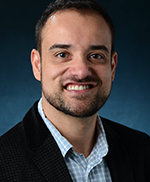Working on the Next Step: ASP’s Andre Luiz Pasqua Tavares Looks Ahead
 Andre Luiz Pasqua Tavares is always thinking ahead to his next career step, while focusing on the work that will help him achieve that next step.
Andre Luiz Pasqua Tavares is always thinking ahead to his next career step, while focusing on the work that will help him achieve that next step.
That forethought and focus has helped Tavares get through dentistry school, attain two post-doctoral fellowships in some of the most esteemed labs and receive independent R03 grant funding for his research identifying Six1-regulated genes and characterizing Six1 co-factors during craniofacial skeletal development.
Next up for Tavares, is two years of professional development activities as one of three scholars inducted into the new Anatomy Scholars Program (ASP), a program designed to support and increase retention of Underrepresented Minorities (URM) in STEM academia in the United States and Canada.
“As a member of an underrepresented group, participation in such program is a great opportunity to advance in our careers and overcome some hurdles we often encounter,” said Tavares, who identifies as Latino.
During his dentistry training at the School of Pharmacy and Dentistry of Alfenas/EFOA - Federal University of Alfenas/UNIFAL, Tavares specialized in the field of developmental biology, with emphasis in cardiovascular and craniofacial biology and development.
He received broad training in anatomy, histology and cell and molecular biology while working on his master’s and Ph.D. at Federal University of Minas Gerais.
While working on his Ph.D. dissertation, Tavares was awarded a grant from the Brazilian government to travel abroad and work in the laboratory of Dr. Raymond Runyan at the University of Arizona where he later became a postdoctoral research scholar.
His training in dentistry led to a second post-doctoral fellowship in the laboratory of Dr. David Clouthier at the University of Colorado Anschutz Medical Campus.
Cranial development has long been at center of his research, including working with different transgenic mouse lines, zebrafish, and different cell lines relevant to craniofacial development. Currently, Tavares is an assistant research professor at George Washington University (GW), where his independent research focuses on understanding the role of Six1 in BOR and craniosynostosis using mouse and Xenopus.
By uncovering the role of Six1 variants in the pathophysiology of these structural birth defects and by uncovering novel potential causative genes (Six1-associated genes), these studies will help patients and their families understand the genetic causes of these Six1-related birth defects, and lead to preventive and corrective strategies in the near future.
Tavares joined AAA in 2007 as a postdoctoral fellow at the University of Arizona. After a gap in membership while working in Denver, he rejoined AAA in 2020. His timing could not have been better. Soon after rejoining, Tavares received an email from his department chair about the new ASP program. Tavares applied and was soon accepted.
“I am looking forward to the opportunity of expanding my professional network,” Tavares said. “I also am excited that I will be able to share professional and career experiences with peers in the program.”